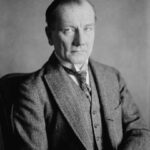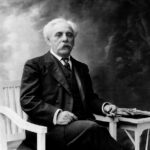Ernő Dohnányi’s composition Symphonic Minutes comprises of five short movements, each only a couple of minutes long. It has undoubtedly become one of the composer’s most popular works, a popularity that predates the more recent renaissance in the composer’s fortunes. Indeed for the past few decades, it has been performed regularly in Hungary and could frequently be heard on the radio.
We can thank Dohányi’s second wife, Elza Galafrs for the work’s inception. Elza was a Berlin born actress and from 1912 Dohnániy regarded her as a collaborative partner for his own stage music creations. It was she who successfully mounted Dohnányi’s pantomime Pierette in Vienna, where earlier it had been a failure.
Dohnányi had long been preoccupied with the thought of turning his successful Ruralia Hungarica composition into theatre music, but the work was self evidently too short. The Symphonic Minutes are, then, a supplement to the Ruralia movements, and the two cycles combined became the dance legend Holy Torch. This was premiered at the Hungarian State Opera House on December 6th 1934, with choreography by Elza Galafrs, who devised an entirely novel system of notation for the work, writing essentially a dance score. She had long sensed that the traditional method of notating dance steps was both cumbersome and misleading, and so taking the five line system of music as her starting point, she wrote her instructions, which thus became readily comprehensible to even a layman, between five lines, each a few centimetres apart. This contained the music, a textual description of the action, precise movements of the dancers, the placing of the dance groups on the stage and even instructions for the lighting. In the choreography, she endeavoured for the placing of the dancers in each group scene to evoke a Hungarian folk motif. (This remarkable “score” is now on display at the Paris Museum of Dance.)
The composition however was premiered not in its stage version but in an orchestral guise. Earlier of course, there had been occasions when new works by Bartók, Kodály and Dohnányi were premiered together, but this still counted as a very special occasion. The first occasion was the legendary concert marking the 50th anniversary of the unification of Pest, Buda and Óbuda into modern day Budapest, in which Kodály’s Psalmus Hungaricus, Bartók’s Dance Suite and Dohnányi’s Festival Overture were all given their world premieres. Ten years later in 1933, the Orchestra of the Philharmonic Society celebrated its eightieth birthday with a concert that gave the first performances of Kodály’s Galantian Dances, Bartók’s Five Folk Songs with Orchestral Accompaniment, and Dohnányi’s Symphonic Minutes. The critics were enthusiastic – Aladár Tóth wrote appreciatively: “What nation could present three such geniuses at the same time?” He had this to say about Dohnányi’s work: “This little bagatelle is all harmony, form and lightness, which frolics in one place, is capricious in another, and pure song elsewhere; when it is witty it is also wild, in other words, a divertimento which not only entertains the mind but also raises the soul. It transfixes and liberates.”
We think of Dohnányi’s artistry in terms of its light handed composition, its virtuosity, its remarkable craftsmanship and its largely unclouded, upbeat charm. The score of Symphonic Minutes matches these expectations perfectly.
The opening moment, marked Capriccio, is awash with filigree woodwind passages which evoke the technique of German Romantic piano virtuosity, although perhaps we ought rather to think in terms of Mendelssohn’s fairy music. The handling of the orchestra and the richness and virtuosity of the orchestration evokes the art of Richard Strauss.
The Rhapsody movement begins with a sad, discursive melody on the cor anglais to which the clarinet responds. In this evocative music, we encounter both the nature music of late Romanic opera – for example Wagner’s shepherd boy’s melody (and we also hear a near verbatim quotation from Tristan) – coupled with a night monologue closely related to folk music that occurs often in the works of Kodály and Wagner.
At the centre of the work is the Scherzo which is momentous robustly orchestrated dance music. We could be forgiven for thinking we can hear the influence of Prokofiev. The brass sonorities of the emotional, lyrical melody that counterpoints the boisterous principal section is late Romantic in character, although we can find similar emotional devices employed by film composers in the mid 1950s.
Dohnányi’s Symphonic Minutes also employs a self-explanatory variation form. The Tema con variazioni takes as its subject matter a nobly simple 16th century melody (“Tema del seicento”). The variations initially resolve the rhythm of the theme into soft, constant motion, but then the music takes on a more steely edge. The mood of this music was to return in the chorale of Bartók’s Concerto. The gracefully shaped clarinet melody of the penultimate variation seems very distant from the original theme, but the final variation faithfully returns to the theme, whereupon a celesta joins in, and its secretive sonority raises the music into a hitherto unsuspected ethereal world.
The closing movement (Rondo) is full of energy and again, we find the virtuosity of the opening fairy scherzo music. But here the music takes on folk music character: it is good humoured, cloudless and joyful, a fitting successor to Brahms’ Hungarian Dances.
Although Dohnányi’s composition is a treasure trove of musical historical associations, when we hear the five movements performed together, we derive an unmistakeable impression of a first rate musical personality.
 An impassioned pianist who infuses his performances with emotion, Godwin seems to embody every note he plays, and his sentiment resonates in his listeners. In 2022, he took first place at the OSM Competition (and received the prize for best interpretation of the imposed Canadian work). He also placed first in piano at the National Music Festival (2015), won the Glenn Gould School Concerto Competition (2019), and took second place at the PianoArts North American Competition in Milwaukee (2022).
An impassioned pianist who infuses his performances with emotion, Godwin seems to embody every note he plays, and his sentiment resonates in his listeners. In 2022, he took first place at the OSM Competition (and received the prize for best interpretation of the imposed Canadian work). He also placed first in piano at the National Music Festival (2015), won the Glenn Gould School Concerto Competition (2019), and took second place at the PianoArts North American Competition in Milwaukee (2022).


 “Intensely soulful… Virtuoso” The New York Times
“Intensely soulful… Virtuoso” The New York Times